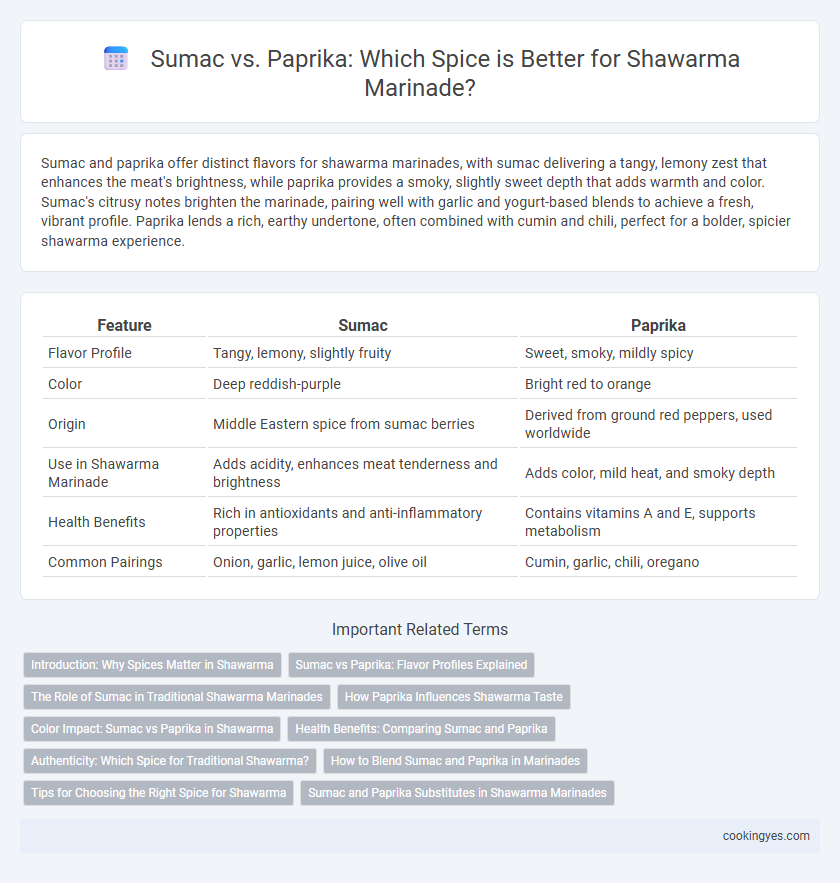Sumac and paprika offer distinct flavors for shawarma marinades, with sumac delivering a tangy, lemony zest that enhances the meat's brightness, while paprika provides a smoky, slightly sweet depth that adds warmth and color. Sumac's citrusy notes brighten the marinade, pairing well with garlic and yogurt-based blends to achieve a fresh, vibrant profile. Paprika lends a rich, earthy undertone, often combined with cumin and chili, perfect for a bolder, spicier shawarma experience.
Table of Comparison
| Feature | Sumac | Paprika |
|---|---|---|
| Flavor Profile | Tangy, lemony, slightly fruity | Sweet, smoky, mildly spicy |
| Color | Deep reddish-purple | Bright red to orange |
| Origin | Middle Eastern spice from sumac berries | Derived from ground red peppers, used worldwide |
| Use in Shawarma Marinade | Adds acidity, enhances meat tenderness and brightness | Adds color, mild heat, and smoky depth |
| Health Benefits | Rich in antioxidants and anti-inflammatory properties | Contains vitamins A and E, supports metabolism |
| Common Pairings | Onion, garlic, lemon juice, olive oil | Cumin, garlic, chili, oregano |
Introduction: Why Spices Matter in Shawarma
Sumac and paprika each bring unique flavor profiles essential for authentic shawarma marinade, enhancing the dish's depth and aroma. Sumac offers a tangy, lemony brightness that balances rich meats, while paprika provides a smoky, slightly sweet warmth that intensifies the savory notes. Choosing between these spices impacts the marinade's complexity, showcasing the importance of spice selection in achieving the perfect shawarma taste.
Sumac vs Paprika: Flavor Profiles Explained
Sumac imparts a tangy, lemony zest that brightens shawarma marinades with subtle citrus notes, enhancing the meat's natural flavors. Paprika offers a mild, smoky sweetness that adds depth and warmth, often contributing a vibrant red hue to the dish. Opting for sumac emphasizes acidity and freshness, while paprika enriches the marinade with earthiness and color, defining distinct flavor profiles for shawarma.
The Role of Sumac in Traditional Shawarma Marinades
Sumac plays a crucial role in traditional shawarma marinades by imparting a tangy, lemony flavor that brightens the meat without overpowering its natural taste. Unlike paprika, which adds a smoky, mildly sweet heat, sumac enhances the complexity of the marinade through its acidic notes, helping to tenderize the meat and balance the richness of the fat. This unique citrusy tang of sumac is essential for achieving the authentic, vibrant flavor profile characteristic of Middle Eastern shawarma recipes.
How Paprika Influences Shawarma Taste
Paprika adds a mild sweetness and vibrant red color to shawarma marinade, enhancing its visual appeal and subtle smoky undertones. This spice balances the sharp, tangy notes contributed by sumac, creating a more rounded flavor profile. Paprika's natural sugars caramelize during cooking, deepening the savory richness typical of authentic shawarma dishes.
Color Impact: Sumac vs Paprika in Shawarma
Sumac adds a deep reddish-purple hue to shawarma marinades, enhancing the visual appeal with a rich, earthy tone that complements the meat's natural color. Paprika, especially smoked or sweet varieties, imparts a vibrant red-orange shade, creating a more intense, eye-catching contrast that highlights the spice profile. Choosing between sumac and paprika directly influences the final color presentation, elevating the shawarma's aesthetic and sensory experience.
Health Benefits: Comparing Sumac and Paprika
Sumac and paprika both offer unique health benefits when used in shawarma marinades, with sumac known for its high antioxidant content that helps reduce inflammation and supports cardiovascular health. Paprika provides vital vitamins like A, E, and B6, which aid in boosting immunity and improving eye health, while also containing capsaicin that may enhance metabolism. Choosing sumac enhances the shawarma with a tangy flavor and potent antioxidants, whereas paprika adds a smoky depth along with vitamins that promote overall wellness.
Authenticity: Which Spice for Traditional Shawarma?
Sumac is the key spice for authentic shawarma marinades, offering a tangy, lemony flavor that enhances the meat's richness and remains true to traditional Middle Eastern recipes. Paprika, while adding a smoky sweetness and vibrant color, is more common in regional variations and less essential for preserving the classic shawarma profile. For an authentic taste, sumac's acidic brightness perfectly balances the spices and complements the slow-roasted meat distinctive to traditional shawarma.
How to Blend Sumac and Paprika in Marinades
Sumac and paprika create a vibrant flavor profile when blended in shawarma marinades, balancing tangy citrus notes with warm, smoky undertones. For optimal results, mix 1 part sumac with 2 parts paprika, combining with garlic, cumin, and olive oil to enhance meat tenderness and aroma. This blend intensifies the savory richness while imparting a subtle acidity that complements grilled lamb, chicken, or beef in authentic Middle Eastern shawarma recipes.
Tips for Choosing the Right Spice for Shawarma
Sumac offers a tangy, lemony flavor that brightens shawarma marinades, making it ideal for those who prefer a vibrant citrusy profile. Paprika provides a warm, smoky sweetness that enhances the richness of the meat, perfect for a deeper, more robust taste. For authentic shawarma, balance the use of sumac and paprika based on desired flavor intensity and regional spice preferences.
Sumac and Paprika Substitutes in Shawarma Marinades
Sumac offers a tangy, lemony flavor that uniquely enhances shawarma marinades, distinguishing it from the sweet, smoky profile of paprika. When sumac is unavailable, lemon zest mixed with a pinch of salt serves as a closer substitute, preserving the essential citrus note in the marinade. Paprika alternatives like smoked chili powder or cayenne pepper provide heat and smokiness but lack sumac's distinctive acidity, emphasizing the importance of choosing substitutes based on flavor balance.
Sumac vs paprika for shawarma marinade Infographic

 cookingyes.com
cookingyes.com